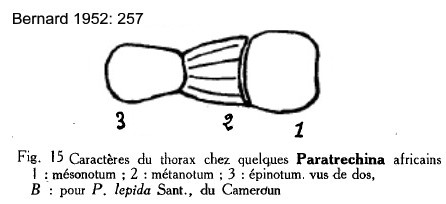Paratrechina lepida
(Santschi)
  Type location Cameroun
(Prenolepis (Nylanderia) lepida n. sp., Santschi, 1915c: 262,
illustrated, worker) collected at Victoria, by Reichensperger; worker
only described (see Bolton, 1995) Type location Cameroun
(Prenolepis (Nylanderia) lepida n. sp., Santschi, 1915c: 262,
illustrated, worker) collected at Victoria, by Reichensperger; worker
only described (see Bolton, 1995)  . .
|
 Santschi's
(1915c) description is at Santschi's
(1915c) description is at  . .
|

Santschi's (1915c) description was -
WORKER - TL 1.9-2.0 mm; head oval, rounded posteriorly. Eyes before the
midline. Clypeus very convex, almost conical, anterior border slightly
scalloped medially. Mandibles with 5-6 teeth. Scape surpassing occiput
by almost half its length; First segment of funiculus three times as
long as the following segments (the shortest). Alitrunk profile
slightly convex, more so than longicornis. Pronotum
as long as anterior width. Mesonotum rounded laterally, as long as
wide. Metanotum much shorter than preceding segment, but almost as
wide, with spiracles almost contiguous dorsally. Propodeum very convex,
regularly rounded and raised dorsally above the level of the mesonotum.
Petiole scale with rounded summit, narrowed basally and somewhat
inclined.
Colour black with hint of brown; edges of mandibles
and funiculus testaceous red; palps, femora on mid and hind legs,
trochanters, joints and tarsi whitish; remainder of appendages
brownish. Smooth and shiny; dorsum of head and mesonotum feebly
reticulate. Erect pilosity brown, quite abundant and sharp; 4 pairs of
macrochaetae on promesonotum. Pubescence translucent.
Holotype worker only from Cameroun, Victoria, by Dr
Reichensperger.
TL ca 2.0-2.4 mm, illustration of
posterior alitrunk (from Bernard, 1952; note the labelling seems to be
to have been wrong and I have changed it to what I feel is correct).
Some characteristics were discussed by Bernard (1952) under Paratrechina
arlesi.
|
 The photomontage
of the type worker is
collated from http://www.antweb.org/specimen.do?name=casent0912305 The photomontage
of the type worker is
collated from http://www.antweb.org/specimen.do?name=casent0912305
|
Note LaPolla, Hawkes & Fisher
(2011) argue for the synonymy of Paratrechina
grisoni under P. lepida
but this seems wrong.
The specimen from Gabon that they
illustrate as lepida (at http://www.antweb.org/specimen.do?name=casent0179591)
is one that I regard as a grisoni.
They do not provide a photograph of the type lepida despite stating they had
examined it. Their description matchs the Forel description of grisoni but differs from the
Santschi description of lepida.
A pointer may be that Bolton, who identified the ants in Belshaw &
Bolton (1994b) separated four species, one very widespread and common
(794 workers from 12 sites), one quite common (48 workers from 5
sites). A very distinctive feature of grisoni,
shown by all the specimens
I have and that I drew in Nigeria, is the mesonotum profile, with a
pronounced raised transverse welt; also the very shiny and the
narrowness at the junction with the
pronotum. LaPolla et al
report and describe a queen and a male for the
species, although neither have been described by earlier authors they provide no information to
support the association of the sexuals with the workers.
|
Oxford University Museum
specimens
Paratrechina lepida
B Taylor det. |
Liberia
E Poirier
Liabala
PF 4
|
2.iv.2013
Nimba County
07°31’06" N
08°35’34" E
|
Pitfall trap
Secondary forest
473 m asl
|
1
|
 |
Paratrechina lepida
B Taylor det. |
Liberia
E Poirier
Liabala
PF 5
|
2.iv.2013
Nimba County
07°31’06" N
08°35’34" E
|
Pitfall trap
Secondary forest
473 m asl
|
1
|
 |
|
 The
photomontage is of a worker from Liberia, Liabala; collector E
Poiriet (Liabala PF V). The
photomontage is of a worker from Liberia, Liabala; collector E
Poiriet (Liabala PF V).
|
 The
photomontage is of a worker from Liberia, Liabala; collector E
Poiriet (Liabala PF IV). The
photomontage is of a worker from Liberia, Liabala; collector E
Poiriet (Liabala PF IV).
|
 Photomontage
of a supposed lepida queen
from Central African Republic; collated from http://www.antweb.org/specimen.do?name=casent0086444 Photomontage
of a supposed lepida queen
from Central African Republic; collated from http://www.antweb.org/specimen.do?name=casent0086444
|
|